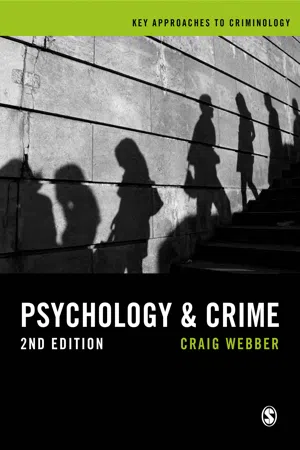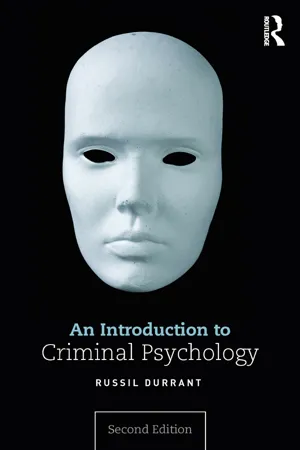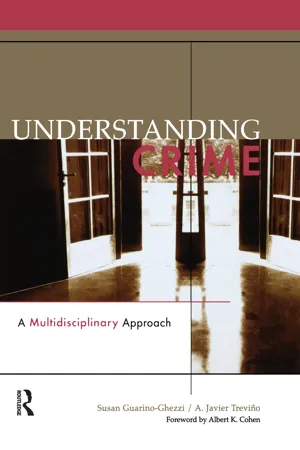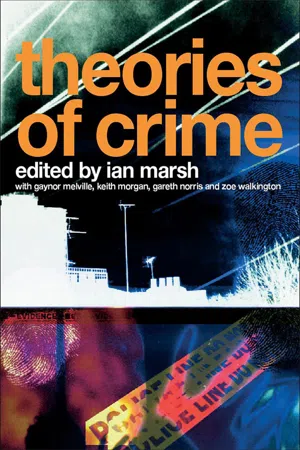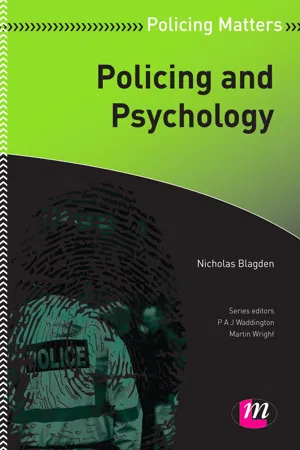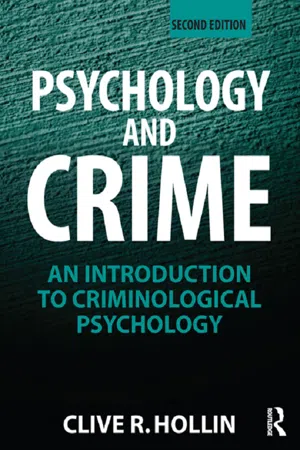Psychology
Understanding Crime
"Understanding Crime" involves studying the psychological, social, and environmental factors that contribute to criminal behavior. It encompasses the exploration of criminal motivations, the impact of upbringing and environment, and the role of mental health in criminal activities. By examining these factors, psychologists aim to develop a deeper understanding of crime and to inform strategies for prevention and intervention.
Written by Perlego with AI-assistance
Related key terms
9 Key excerpts on "Understanding Crime"
- eBook - ePub
- David Canter(Author)
- 2017(Publication Date)
- Routledge(Publisher)
To put subsequent chapters in context, it is useful to think of criminal activity as being part of a process, rather than a particular action or an act committed by a particular type of person. The process starts when people carry out illegal acts, but even those acts are likely to have their roots in earlier experiences. Once the act has been committed, there are then victims and witnesses, as well as other processes that become associated with the act, most notably aspects of law enforcement. Thus, an important feature of crime that emerges if the offence is recognised and reported is the police investigation. Furthermore, the criminal is likely to be part of various social networks that will also influence and be influenced by the crime. Other crimes may also be associated with the initial act, so that the crime itself can become part of an unfolding process of criminality.Psychologists focus on individuals, rather than broader social, political or economic aspects. So, the knowledge that is gained about the psychology of crime has to be gleaned from the acts of offenders, rather than general crime statistics. This means that the task of understanding the underlying cognitive, emotional and interpersonal aspects of the criminality is very dependent on which crimes and criminals it is possible to obtain information about. There is not very much of value for psychologists in the sort of national crime statistics that are the stock in trade of those sociologists who study crime. To understand the individual and social psychological aspects of crimes, details of actual crimes and their perpetrators have to be obtained. This forces the crime psychologist to work mainly in the field with ‘real-world’ data. The tightly controlled laboratory studies favoured by many academic psychologists are just too artificial to provide valid results that can be applied to actual events.THE CHALLENGES OF CRIME PSYCHOLOGY
Yet, when considering criminals and their actions, it has to be borne in mind that a very biased sample of people is being dealt with. For example, in most places, the offender is appprehended in less than 10 per cent of burglaries. There is, thus, an open debate on whether the burglars who get to court or are studied by researchers are typical of all burglars or are, possibly, the less competent ones who do not escape arrest. By contrast, around the developed world, as many as 95 per cent of murderers are caught. This means that studies of those who kill others may be more representative of the range and variety of homicides than is the case for most other crimes. It also means that there is more information on this very rare crime than for other crimes that are far more prevalent. - eBook - ePub
Psychology and Crime
A Transdisciplinary Perspective
- Craig Webber(Author)
- 2019(Publication Date)
- SAGE Publications Ltd(Publisher)
2 Psychological Perspectives on Crime Overview Moving on from a historical overview of social scientific understanding of crime, this chapter looks at the different psychological perspectives that constitute psychology. We will see that although they are sometimes presented as discrete areas of research, in fact there is some significant overlap between them. If we want to understand the problem of many accounts of crime, both sociological and psychological, then we can interrogate them through the lens of age. One of the key criminological truisms is that most people grow out of crime (Rutherford 1986/2002). This will be a recurring theme of this chapter so that the different psychological perspectives can be understood through issues like aging and desistance from crime. Key terms ■ Psychological Perspectives; Biological Psychology; Behaviourism; Cognitive Psychology; Psychoanalysis; Social Psychology The previous chapter explored the main approaches to Understanding Crime as they developed historically; this next chapter is a more in-depth overview of some of the major psychological approaches to studying human behaviour. This is not meant to be an exhaustive overview, merely a reminder for those who have already studied psychology, and an introduction for those who have not. All psychological approaches share the common focus of studying internal mental processes. Psychology can be distinguished from psychiatry through the latter’s focus on the study and treatment of mental illness and emotional disturbance. Psychiatry is a branch of medicine that, for the most part, focusses on illness and derivations from ‘normal’ 1 behaviour. Psychology is interested in a broader range of human behaviour that includes mental functions such as perception (e.g. taste, colour or object sizes), the capacity and ability of memory, as well as behaviour that some might describe as ‘abnormal’ such as aggression - eBook - ePub
- Russil Durrant(Author)
- 2018(Publication Date)
- Routledge(Publisher)
Given the strengths and limitations of the three types of approach for measuring crime and criminal behaviour, how should we go about determining the nature and prevalence of crime in society? As with other types of research enquiry, the best approach is to draw on a diverse range of research methods rather than to rely predominantly or exclusively on one source of data. If we can demonstrate similar patterns across different sources of data then we are in a stronger position to claim that the particular phenomenon that we are interested in is a ‘robust’ one and not simply an artefact of the particular source of data. Throughout this book we will draw on a range of different sources of information about crime, alongside various different research methodologies for understanding criminal behaviour.REVIEW AND REFLECT
1 How would you define ‘crime’?2 What are some of the advantages and disadvantages of using official crime statistics?WHAT IS CRIMINAL PSYCHOLOGY?
This book is centrally concerned with the application of psychology to our understanding of criminal behaviour. Let us pause for a moment to reflect on what this actually entails. As every introductory psychology textbook will quickly tell us, psychology is ‘the science of mental processes and behavior’ (e.g., Kosslyn & Rosenberg, 2004, p. 4). Criminology textbooks are rather less concise or uniform in how they define their discipline, but, broadly speaking, criminology is defined as the study of crime, criminal behaviour, and responses to crime (e.g., Newburn, 2013). Criminal psychology, then, critically involves the use of psychology as a science to advance our understanding of the causes of crime. Psychology here refers to the academic discipline of psychology (which includes the study, among other things, of brain processes, development, cognition, personality, social influence, and culture) not just peoples’ thinking process and personality (as in the psychological level of analysis - eBook - ePub
Understanding Crime
A Multidisciplinary Approach
- Susan Guarino-Ghezzi, A. Javier Trevino(Authors)
- 2014(Publication Date)
- Routledge(Publisher)
While psychologists differ in their orientations and interests, depending on their subfields, all are primarily concerned with behavior—with how and why an individual acts as he or she does. Almost all psychologists believe that the brain’s physiology, our psychological development, and our social experiences are important in understanding behavior in general, and criminal behavior in particular. Psychology is too complex a discipline for any one to be an expert in all subfields. While most psychologists specialize in one or two subfields, they all have a general understanding of the discipline, which results in a common language.Theoretical Contributions of Psychology to Understanding Crime
There is no comprehensive, generally accepted psychological theory of criminal behavior. Psychologists draw on a wide variety of theories. The contributions of psychological theories to our understanding of crime can be put into three main categories.- General psychological theories that attempt to explain all human behavior, which are applied to the area of crime . These include personality theory, developmental theory, learning theory, social psychology, and physiological psychological theory.
- Psychological theories specifically developed to explain criminal conduct . These theories are often extensions of one or more general theories of behavior and are typically more narrow in scope. They frequently reflect the theorist’s particular orientation and do not attempt to integrate what is known generally about behavior and criminal conduct.
- Psychological theories that focus on specific types of crimes , such as stalking, rape, or domestic violence. Here there is an even narrower focus. Theories that endeavor to explain or understand a particular criminal act may or may not be applicable to other types of criminal conduct. This is the case even with general categories or types of criminal conduct such as sexual offending. For example, the personality characteristics that lead men to rape women might be quite different from the personality characteristics of men who molest children.
Some theories focus more generally on violence and aggression, and not specifically on crime. While some forms of aggression such as assault and murder are illegal, others, such as defending oneself, are not. Psychological theories are frequently interwoven with theories of violence, requiring that we deduce from the latter what is relevant to the study of crime. In order to understand criminal behavior, psychologists must move back and forth between the three aforementioned categories of psychological theory, extracting relevant information from each category. - eBook - ePub
- Ian Marsh(Author)
- 2007(Publication Date)
- Routledge(Publisher)
CHAPTER 3Psychological Explanations for Criminal Behaviour
INTRODUCTION
For many centuries, we have attempted to find out which people are likely to become criminals and what drives certain individuals to commit a particular type of crime in the first place. Over the years psychologists have considered a range of different explanations in order to answer these difficult questions. Some have argued that there may be a genetic explanation which is at the centre of explaining criminal behaviour; others have suggested that it is the environment in which people live which can influence their chance of becoming criminal.At different periods in history these ideas have been prominent in the minds of not only psychologists but also other professionals and the public alike. However nobody has seemingly provided a comprehensive and infallible answer to the question of criminality. This chapter will introduce some of the key theories that psychologists have attempted to use to explain criminal behaviour, such as personality, social factors and cognition.CRIMINALITY AS AN ELEMENT OF PERSONALITY
It is common for us to attach labels to criminals and attempt to explain their behaviour through describing them as possessing a certain character trait. For example, it is common to refer to some criminals as ‘psychos’—particularly in films and the newspapers. This type of person is actually called a psychopath and labels such as these have been developed by psychologists to help us understand the different types of personality category that people fit into. Not all of these are criminal, but it is assumed that many criminals possess similar personality characteristics. Clearly there are some important factors to criminality that can be explained by situational and developmental factors, but there is also the psychological element to criminal activity that is relatively unique to that individual. One possible explanation for this desire to uncover the psychological traits of offenders is that it provides a quantifiable difference between ‘us’ and ‘them’ and to some extent further defines law-breakers as being almost another ‘breed’ of person. The following section will describe the different explanations of criminal personality - eBook - ePub
- Francis Pakes, Jane Winstone(Authors)
- 2013(Publication Date)
- Willan(Publisher)
These accounts illustrate that asking ‘why’ is not necessarily the right question. To understand offending behaviour so that we can predict or prevent it requires a different type of analysis. That is what this chapter is about. Before he became prime minister, Tony Blair launched a famous slogan when he said that New Labour would be ‘tough on crime, tough on the causes of crime’ (Blair 1993). In order to start our enquiry, we must develop ideas about what we actually mean when we talk about the causes of crime. After that, this chapter will outline various biological, psychological and social explanations of crime. Biological factors include genes, hormones, and brain injury or dysfunction. Psychological factors include personality, a factor known as self-control, and the concept of sensation seeking. We will also examine the role of the family. Sociological factors include poverty, subcultures and a concept called strain. In the end, we examine factors that might prevent people from committing crime.Understanding causes of crime
When psychologists or criminologists talk about offending behaviour, they are often talking about causes of crime rather than motives. We do not necessarily need to know what the offender was thinking at the time of the offence. It is anyway doubtful whether that is where reliable answers can be found. After all, we can only uncover that by asking the offender, and it is very possible that the answer will be influenced by demand characteristics (that is, the expectation of what the interviewer wants to hear) and concerns of self-presentation (that is, the desire to leave a particular impression of oneself); for example, Douglas and Olshaker (1997) argue that asking such questions often brings about well-rehearsed self-serving answers, rather than anything nearer to the truth.Instead, psychologists and criminologists are usually concerned with what the social and psychological factors are that contribute to the offending behaviour. Thus, when we talk about the causes of crime, psychologists and criminologists tend to look at general factors that apply to offending and offenders in a way that is disproportionate. If most offenders share a characteristic which non-offenders do not, that might be identified as a possible correlate of crime. Whether that characteristic is anything to do with actually producing crime is a different matter. That is a key question when deciding to call a factor a cause - eBook - ePub
- Nicholas Blagden(Author)
- 2012(Publication Date)
- Learning Matters(Publisher)
2Psychological theories of crime and criminal behaviour
CHAPTER OBJECTIVES
By the end of this chapter you should be able to:- understand some of the main psychological theories of crime and criminal behaviour;
- apply these theories to case studies and real-world policing examples;
- think critically about psychological theories of crime and their application to criminal behaviour.
LINKS TO STANDARDSThis chapter provides opportunities for links with the following Skills for Justice, National Occupational Standards (NOS) for Policing and Law Enforcement 2008.AE1 Maintain and develop your knowledge, skills and competence. HA2 Manage your own resources and professional development. HF15 Provide information to support decision making. With the introduction of the Qualification and Credit Framework (QCF), it is likely that the term ‘National Occupational Standards’ will change. At the time of writing, it is not clear what the new title will be, although it is known that some organisations will use the term ‘QCF assessment units’.Links to current NOS are provided at the start of each chapter; however, it should be noted that these are currently subject to review and it is recommended that you visit the Skills for Justice website to check the currency of all the NOS provided: www.skillsforjustice-nosfinder.com .Introduction
Why people commit crime is something that academics and practitioners have tried to explain for many years. This chapter explores some of the main psychological theories that can help explain and predict why some people commit crime and others do not. The chapter aims to provide an in-depth summary of some of the key theories, including psycho-biological, social and cognitive-behavioural approaches. Through an understanding of these theories students, particularly those pursuing careers within law enforcement agencies, will gain an insight into the many factors that influence criminal behaviour. An understanding of these theories will broaden students’ and trainee police officers’ perceptions on what (if anything concrete) causes offending behaviour. - eBook - ePub
Crime and Intelligence Analysis
An Integrated Real-Time Approach
- Glenn Grana, James Windell(Authors)
- 2016(Publication Date)
- Routledge(Publisher)
There has been growing research in recent years to show that there is a link between mental illness and criminal behavior. That is, when people have such serious mental illness as schizophrenia, bipolar disorder, and severe depression, there appears to be an increased risk for serious, violent crimes. Studies in recent years have found a positive relationship between psychotic disorders and criminal violence (Siegel, 2006).Other psychologists developed a cognitive theory of crime hypothesized that criminal offending results from habits of thought and interpretations of reality. More recent refinements of cognitive theory suggest that criminals interpret situations differently than noncriminals. For example, criminal offenders might tend to view situations in more hostile ways and then are most likely to respond with aggressive behavior.Reacting against psychoanalytic and dynamic psychological explanations were psychologists and psychiatrists such as Samuel Yochelson and Stanton Samenow, who rejected the idea that criminal behavior was a symptom of buried conflicts. Yochelson and Samenow theorized that criminals choose to commit crimes and that the cause is the way they think. All criminals are alike, Yochelson and Samenow concluded, in how they think; they think in distorted and twisted ways. Punishment, however, will not cure distorted and criminal thinking. They must be taught to think differently (Samenow, 1984).Sociological ExplanationsSociological explanations of crime look at criminal behaviors as emanating from environmental influences. Early and influential sociological theories were proposed beginning in the 1930s. For example, Edwin Sutherland suggested that delinquent behavior is learned in much the same way that people learn other things—by observation, role modeling, and reinforcement.Sutherland called his learning process theory differential association, and he proposed that an individual becomes a criminal by associating with people who condone violation of the law. In effect, criminal attitudes are learned from others (Cole and Smith, 2007). - eBook - ePub
Psychology and Crime
An Introduction to Criminological Psychology
- Clive R. Hollin(Author)
- 2013(Publication Date)
- Routledge(Publisher)
causes – biological, or psychological, or social, or a mixture of all three – of criminal behaviour. Research with a focus on causal relationships is often allied to scientific philosophies and methodologies that aim to control, measure, and determine relationships between sets of variables. The aim of such scientific research is to produce empirical findings that are reliable, verifiable, and replicable. This approach to research is characteristic of a positivism, a style of social research with a long history (Halfpenny, 1982/1992). It has become fashionable in some quarters to disparage positivism (Smith, 2004) although, as Halfpenny (1982/1992: 11) states: ‘There are differences among anti-positivists, who use the term loosely and indiscriminately to describe all sorts of disfavoured forms of inquiry’.Another criticism of psychological research applied to criminal behaviour, stretching back to Lombroso and Freud, is that there is an undue stress on defects, deficits, and developmental delays. Thus, rather than Durkheim’s normality of crime, psychological theories stress the ways in which the offender is different to the normal, non-criminal population. This emphasis had an effect on the way a psychological perspective was appraised by some criminologists: ‘Psychological theories are useful as explanations of the behavior of deeply disturbed, impulsive, or destructive people. However, they are limited as general explanations of criminality. For one thing, the phenomenon of crime and delinquency is so widespread that to claim that all criminals are psychologically disturbed is to make that claim against the vast majority of people’ (Siegal, 1986:175–6). Siegal’s point regarding psychological disturbance and criminal behaviour is further discussed in Chapter 8 .The approach to explaining criminal behaviour as seen so far is one of applying a theory to criminal behaviour then setting about the task of research. However, a different approach is to use empirical research to formulate an understanding of criminal behaviour. The longitudinal research investigating the development of anti-social and criminal behaviour, has added significantly to our appreciation of the aetiological complexity of these forms of behaviour. The longitudinal research, including the work of David Farrington and Terrie Moffitt, is discussed in the following chapter.
Learn about this page
Index pages curate the most relevant extracts from our library of academic textbooks. They’ve been created using an in-house natural language model (NLM), each adding context and meaning to key research topics.

